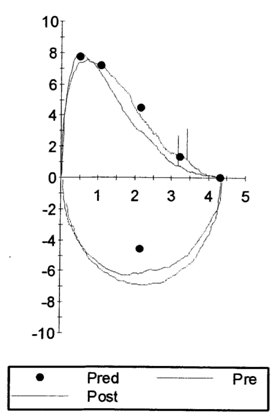
Pulmonary Function Testing
Case 1 Answer
A 65 year-old man undergoes pulmonary function testing as part of a routine health-screening test. He has no pulmonary complaints. He is a lifelong non-smoker and had a prior history of asbestos exposure while serving in the Navy. His pulmonary function test results are as follows:
| Pre-Bronchodilator (BD) | Post- BD | |||
|---|---|---|---|---|
| Test | Actual | Predicted | % Predicted | % Change |
| FVC (L) | 4.39 | 4.32 | 102 | -1 |
| FEV1 (L) | 3.20 | 3.37 | 95 | 7 |
| FEV1/FVC (%) | 73 | 78 | 8 | |
| FRC (L) | 3.17 | 3.25 | 98 | |
| ERV (L) | 0.63 | 0.93 | 68 | |
| RV (L) | 2.54 | 2.32 | 109 | |
| TLC (L) | 6.86 | 6.09 | 113 | |
| DLCO* uncorr | 25.69 | 31.28 | 82 | |
| DLCO corr | 26.14 | 31.28 | 84 | |
| *DLCO is measured in ml/min/mmHg | ||||
| Check abbreviations>> | ||||
His flow volume loops is as follows:

Case 1 Interpretation
This case demonstrates an example of normal pulmonary function tests. The FVC and the FEV1 are 102% and 95% of predicted, respectively, values well above the lower limit of normal and the FEV1/FVC ratio is greater than the predicted value minus 8. The flow-volume loop also corresponds quite nicely to the predicted values for this patient (darkened circles). Based on this normal spirometry pattern, you would conclude that there is no evidence of air-flow obstruction. The patient also has normal total lung capacity, indicating that there is no evidence of restriction, and a normal diffusing capacity for carbon monoxide, indicating that the alveolar-capillary surface area for gas exchange is normal. There is no bronchodilator response.
UW School of Medicine : School of Medicine Mission
Copyright and Disclaimer : Credits and Acknowledgements